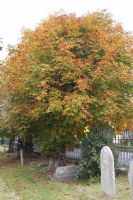

|
|
|
Holly (Ilex Aquifolia) Holly (Ilex Aquifolia) Date added: 04/12/2020 17:02:34 The holly and the ivy, The words of this old carol date back to at least 1700 and probably have much earlier origins. The “crown” may be a reference to the headgear of the Druidical figure of the Holly King, the Lord of the winter wild wood. As we know, Christmas is going to be very different this year and for many, a sad time because of the Covid pandemic but nothing says “ Xmas “more emphatically than the bright red berries and the glossy dark green leaves of the holly which is flourishing in the cemetery ( see recent photo ) Trees of this family have been around for the last 50 million years and it is one of very few evergreen trees in Britain. It prefers moist areas but can also tolerate heat, drought and frost. Growth is slow and the tree will reach 4 metres or more and is very long lived - up to 500 years. Many forms of wildlife depend on the holly to provide food and shelter including deer, squirrels , hibernating hedgehogs and at least 18 species of birds . Earlier in the year, insects such as bees, wasps and flies feed on the nectar found in the white four- petalled flowers. Medicinally, the leaves have been used to treat fevers and arthritis and for their diuretic and laxative effects. However,as with so many other plants, holly can be harmful. The alkaloids are toxic to humans and also to horses, cats and dogs : just a few berries could be fatal to a child and an overdose of the leaves could kill an adult. The attractive , almost white fine- grained wood can be turned to produce small, mainly decorative items and , in the past was used in making Highland bagpipes and piano keys. In Roman times Holly was associated with the Saturnalia festivities , in honour of the god Saturn, when the whole empire enjoyed seven whole days of wild and boozy indulgence. Around 312 AD, the Christian ruler Constantine introduced a shift towards what we now recognise as Christmas and the sharp leaves and the red berries of holly came to be seen as symbols of the crown of thorns and the blood of Jesus Christ . © FNRC
Images related to this news article |
Website designed and maintained by Paul Thompson on behalf of the Friends of Newtown Road Cemetery.



